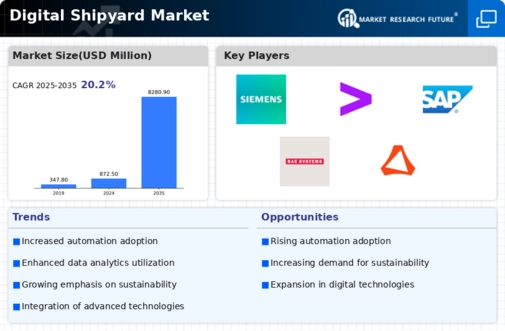-
Executive Summary
-
Market Attractiveness Analysis
- Global Digital Shipyard Market, by Process
- Global Digital Shipyard Market, by Shipyard Type
- Global Digital Shipyard Market, by Capacity
- Global Digital Shipyard Market, by Digitalization Level
- Global Digital Shipyard Market, by Technology
- Global Digital Shipyard Market, by End Use
- Global Digital Shipyard Market, by Region
-
Market Introduction
-
Market Definition
-
Scope of the Study
-
Market Structure
-
Key Buying Criteria
-
Market Factor Indicator Analysis
-
Research Methodology
-
Research Process
-
Primary Research
-
Secondary Research
-
Market Size Estimation
-
Product Model
-
List of Assumptions
-
Market Insights
-
Market Dynamics
-
Introduction
-
Drivers
- Rise in Adoption of Digital Twin in Shipbuilding Industry
- Rise in International Seaborne Trade
- Increasing Procurement of Advanced Vessels by Navies Across the World
- Drivers Impact Analysis
-
Restraints
- Issues Related to Cyber Threats
- High Cost of Acquisition
- Restraints Impact Analysis
-
Opportunities
-
Market/Technological Trends
-
Patent Trends
-
Regulatory Landscape/Standards
-
Market Factor Analysis
-
Supply Chain Analysis
- R&D
- Manufacturing
- Distribution & Sales
- Post-Sales Monitoring
-
Porter’s Five Forces Analysis
- Threat of New Entrants
- Bargaining Power of Suppliers
- Bargaining Power of Buyers
- Threat of Substitutes
- Rivalry
-
Global Digital Shipyard Market, by Process
-
Introduction
-
Research & Development
-
Design & Engineering
-
Manufacturing & Planning
-
Maintenance & Support
-
Training & Simulation
-
Global Digital Shipyard Market, by Shipyard Type
-
Introduction
-
Commercial Shipyards
-
Military Shipyards
-
Global Digital Shipyard Market, by Capacity
-
Introduction
-
Small Shipyards
-
Medium Shipyards
-
Large Shipyards
-
Global Digital Shipyard Market, by Digitalization Level
-
Introduction
-
Fully Digital Shipyard
-
Semi Digital Shipyard
-
Partially Digital Shipyard
-
Global Digital Shipyard Market, by Technology
-
Introduction
-
Augmented & Virtual Reality (AR & VR)
-
Digital Twin & Simulation
-
Additive Manufacturing
-
Artificial Intelligence & Big Data Analytics
-
Robotic Process Automation
-
Industrial Internet of Things (IIoT)
-
Cybersecurity
-
Blockchain
-
Cloud Computing & Master Data Management
-
Global Digital Shipyard Market, by End Use
-
Introduction
-
Implementation
-
Upgrades & Services
-
Global Digital Shipyard Market, by Region
-
Introduction
-
North America
- US
- Canada
-
Europe
- UK
- Germany
- France
- Russia
- Netherlands
- Rest of Europe
-
Asia-Pacific
- China
- India
- Japan
- South Korea
- Rest of Asia-Pacific
-
Middle East
- UAE
- Saudi Arabia
- Israel
- Rest of the Middle East
-
Rest of the World
- Latin America
- Africa
-
Competitive Landscape
-
Competitive Overview
-
Competitor Dashboard
-
Major Growth Strategies in the Global Digital Shipyard Market
-
Competitive Benchmarking
-
Market Share Analysis
-
Leading Player in Terms of Number of Developments in the Global Digital Shipyard Market
-
Key Developments & Growth Strategies
- Product Launches/Service Deployments
- Mergers & Acquisitions
- Joint Ventures
-
Company Profiles
-
Key Market Players
-
(Company overview, products & services offered, financial overview, key developments, SWOT analysis, and key strategies to be covered for public companies)
-
Siemens
-
Dassault Systèmes
-
AVEVA Group plc
-
Accenture
-
SAP SE
-
BAE Systems
-
Hexagon AB
-
Altair Engineering, Inc.
-
Wärtsilä
-
IBM Corporation
-
Other Prominent Players
-
Inmarsat Plc
-
IFS AB
-
Pemamek Ltd.
-
Aras Corporation
-
Kreyon Systems Pvt. Ltd
-
KUKA AG
-
iBASEt
-
PROSTEP Inc.
-
KRANENDONK Smart robotics
-
Damen Shipyards Group
-
Navantia
-
Appendix
-
References
-
Related Reports
-
List of Abbreviations
-
List of Tables
-
List of Assumptions
-
Major Patents Granted for Digital Shipyard (2014–2020)
-
Global Digital Shipyard Market, by Process, 2020–2030 (USD Million)
-
Global Digital Shipyard Market, by Capacity, 2020–2030(USD Million)
-
Global Digital Shipyard Market, by Digitalization Level, 2020–2030 (USD Million)
-
Global Digital Shipyard Market, By Shipyard Type, 2020–2030 (USD Million)
-
Global Digital Shipyard Market, by Technology, 2020–2030 (USD Million)
-
Global Digital Shipyard Market, by End Use, 2020–2030 (USD Million)
-
Global Digital Shipyard Market, by Region, 2020–2030 (USD Million)
-
North America: Digital Shipyard Market, by Country, 2020–2030(USD Million)
-
North America: Digital Shipyard Market, by Process, 2020–2030 (USD Million)
-
North America: Digital Shipyard Market, by Capacity, 2020–2030 (USD Million)
-
North America: Digital Shipyard Market, by Digitalization Level, 2020–2030 (USD Million)
-
North America: Digital Shipyard Market, By Shipyard Type, 2020–2030 (USD Million)
-
North America: Digital Shipyard Market, by Technology, 2020–2030(USD Million)
-
North America: Digital Shipyard Market, by End Use, 2020–2030(USD Million)
-
US: Digital Shipyard Market, by Process, 2020–2030 (USD Million)
-
US: Digital Shipyard Market, by Capacity, 2020–2030 (USD Million)
-
US: Digital Shipyard Market, by Digitalization Level, 2020–2030 (USD Million)
-
US: Digital Shipyard Market, by Shipyard Type, 2020–2030 (USD Million)
-
US: Digital Shipyard Market, by Technology, 2020–2030 (USD Million)
-
US: Digital Shipyard Market, by End Use, 2020–2030 (USD Million)
-
Canada: Digital Shipyard Market, by Process, 2020–2030 (USD Million)
-
Canada: Digital Shipyard Market, by Capacity, 2020–2030 (USD Million)
-
Canada: Digital Shipyard Market, by Digitalization Level, 2020–2030 (USD Million)
-
Canada: Digital Shipyard Market, by Shipyard Type, 2020–2030 (USD Million)
-
Canada: Digital Shipyard Market, by Technology, 2020–2030 (USD Million)
-
Canada: Digital Shipyard Market, by End Use, 2020–2030 (USD Million)
-
Europe: Digital Shipyard Market, by Country, 2020–2030 (USD Million)
-
Europe: Digital Shipyard Market, by Process, 2020–2030 (USD Million)
-
Europe: Digital Shipyard Market, by Capacity, 2020–2030 (USD Million)
-
Europe: Digital Shipyard Market, by Digitalization Level, 2020–2030 (USD Million)
-
Europe: Digital Shipyard Market, by Shipyard Type, 2020–2030 (USD Million)
-
Europe: Digital Shipyard Market, by Technology, 2020–2030 (USD Million)
-
Europe: Digital Shipyard Market, by End Use, 2020–2030 (USD Million)
-
UK: Digital Shipyard Market, by Process, 2020–2030 (USD Million)
-
UK: Digital Shipyard Market, by Capacity, 2020–2030 (USD Million)
-
UK: Digital Shipyard Market, by Digitalization Level, 2020–2030 (USD Million)
-
UK: Digital Shipyard Market, by Shipyard Type, 2020–2030 (USD Million)
-
UK: Digital Shipyard Market, by Technology, 2020–2030 (USD Million)
-
UK: Digital Shipyard Market, by End Use, 2020–2030 (USD Million)
-
Germany: Digital Shipyard Market, by Process, 2020–2030 (USD Million)
-
Germany: Digital Shipyard Market, by Capacity, 2020–2030 (USD Million)
-
Germany: Digital Shipyard Market, by Digitalization Level, 2020–2030 (USD Million)
-
Germany: Digital Shipyard Market, by Shipyard Type, 2020–2030 (USD Million)
-
Germany: Digital Shipyard Market, by Technology, 2020–2030 (USD Million)
-
Germany: Digital Shipyard Market, by End Use, 2020–2030 (USD Million)
-
France: Digital Shipyard Market, by Process, 2020–2030 (USD Million)
-
France: Digital Shipyard Market, by Capacity, 2020–2030 (USD Million)
-
France: Digital Shipyard Market, by Digitalization Level, 2020–2030 (USD Million)
-
France: Digital Shipyard Market, by Shipyard Type, 2020–2030 (USD Million)
-
France: Digital Shipyard Market, by Technology, 2020–2030 (USD Million)
-
France: Digital Shipyard Market, by End Use, 2020–2030 (USD Million)
-
Russia: Digital Shipyard Market, by Process, 2020–2030 (USD Million)
-
Russia: Digital Shipyard Market, by Capacity, 2020–2030 (USD Million)
-
Russia: Digital Shipyard Market, by Digitalization Level, 2020–2030 (USD Million)
-
Russia: Digital Shipyard Market, by Shipyard Type, 2020–2030 (USD Million)
-
Russia: Digital Shipyard Market, by Technology, 2020–2030 (USD Million)
-
Russia: Digital Shipyard Market, by End Use, 2020–2030 (USD Million)
-
Netherlands: Digital Shipyard Market, by Process, 2020–2030 (USD Million)
-
Netherlands: Digital Shipyard Market, by Capacity, 2020–2030 (USD Million)
-
Netherlands: Digital Shipyard Market, by Digitalization Level, 2020–2030 (USD Million)
-
Netherlands: Digital Shipyard Market, by Shipyard Type, 2020–2030 (USD Million)
-
Netherlands: Digital Shipyard Market, by Technology, 2020–2030 (USD Million)
-
Netherlands: Digital Shipyard Market, by End Use, 2020–2030 (USD Million)
-
Rest of Europe: Digital Shipyard Market, by Process, 2020–2030 (USD Million)
-
Rest of Europe: Digital Shipyard Market, by Capacity, 2020–2030 (USD Million)
-
Rest of Europe: Digital Shipyard Market, by Digitalization Level, 2020–2030 (USD Million)
-
Rest of Europe: Digital Shipyard Market, by Shipyard Type, 2020–2030 (USD Million)
-
Rest of Europe: Digital Shipyard Market, by Technology, 2020–2030 (USD Million)
-
Rest of Europe: Digital Shipyard Market, by End Use, 2020–2030 (USD Million)
-
Asia-Pacific: Digital Shipyard Market, by Country, 2020–2030 (USD Million)
-
Asia-Pacific: Digital Shipyard Market, by Process, 2020–2030 (USD Million)
-
Asia-Pacific: Digital Shipyard Market, by Capacity, 2020–2030 (USD Million)
-
Asia-Pacific: Digital Shipyard Market, by Digitalization Level, 2020–2030 (USD Million)
-
Asia-Pacific: Digital Shipyard Market, by Shipyard Type, 2020–2030 (USD Million)
-
Asia-Pacific: Digital Shipyard Market, by Technology, 2020–2030 (USD Million)
-
Asia-Pacific: Digital Shipyard Market, by End Use, 2020–2030 (USD Million)
-
China: Digital Shipyard Market, by Process, 2020–2030 (USD Million)
-
China: Digital Shipyard Market, by Capacity, 2020–2030 (USD Million)
-
China: Digital Shipyard Market, by Digitalization Level, 2020–2030 (USD Million)
-
China: Digital Shipyard Market, by Shipyard Type, 2020–2030 (USD Million)
-
China: Digital Shipyard Market, by Technology, 2020–2030 (USD Million)
-
China: Digital Shipyard Market, by End Use, 2020–2030 (USD Million)
-
India: Digital Shipyard Market, by Process, 2020–2030 (USD Million)
-
India: Digital Shipyard Market, by Capacity, 2020–2030 (USD Million)
-
India: Digital Shipyard Market, by Digitalization Level, 2020–2030 (USD Million)
-
India: Digital Shipyard Market, by Shipyard Type, 2020–2030 (USD Million)
-
India: Digital Shipyard Market, by Technology, 2020–2030 (USD Million)
-
India: Digital Shipyard Market, by End Use, 2020–2030 (USD Million)
-
Japan: Digital Shipyard Market, by Process, 2020–2030 (USD Million)
-
Japan: Digital Shipyard Market, by Capacity, 2020–2030 (USD Million)
-
Japan: Digital Shipyard Market, by Digitalization Level, 2020–2030 (USD Million)
-
Japan: Digital Shipyard Market, by Shipyard Type, 2020–2030 (USD Million)
-
Japan: Digital Shipyard Market, by Technology, 2020–2030 (USD Million)
-
Japan: Digital Shipyard Market, by End Use, 2020–2030 (USD Million)
-
South Korea: Digital Shipyard Market, by Process, 2020–2030 (USD Million)
-
South Korea: Digital Shipyard Market, by Capacity, 2020–2030 (USD Million)
-
South Korea: Digital Shipyard Market, by Digitalization Level, 2020–2030 (USD Million)
-
South Korea: Digital Shipyard Market, by Shipyard Type, 2020–2030 (USD Million)
-
South Korea: Digital Shipyard Market, by Technology, 2020–2030 (USD Million)
-
South Korea: Digital Shipyard Market, by End Use, 2020–2030 (USD Million)
-
Rest of Asia-Pacific: Digital Shipyard Market, by Process, 2020–2030 (USD Million)
-
Rest of Asia-Pacific: Digital Shipyard Market, by Capacity, 2020–2030 (USD Million)
-
Rest of Asia-Pacific: Digital Shipyard Market, by Digitalization Level, 2020–2030 (USD Million)
-
Rest of Asia-Pacific: Digital Shipyard Market, by Shipyard Type, 2020–2030 (USD Million)
-
Rest of Asia-Pacific: Digital Shipyard Market, by Technology, 2020–2030 (USD Million)
-
Rest of Asia-Pacific: Digital Shipyard Market, by End Use, 2020–2030 (USD Million)
-
Middle East: Digital Shipyard Market, by Country, 2020–2030 (USD Million)
-
Middle East: Digital Shipyard Market, by Process, 2020–2030 (USD Million)
-
Middle East: Digital Shipyard Market, by Capacity, 2020–2030 (USD Million)
-
Middle East: Digital Shipyard Market, by Digitalization Level, 2020–2030 (USD Million)
-
Middle East: Digital Shipyard Market, by Shipyard Type, 2020–2030 (USD Million)
-
Middle East: Digital Shipyard Market, by Technology, 2020–2030 (USD Million)
-
Middle East: Digital Shipyard Market, by End Use, 2020–2030 (USD Million)
-
UAE: Digital Shipyard Market, by Process, 2020–2030 (USD Million)
-
UAE: Digital Shipyard Market, by Capacity, 2020–2030 (USD Million)
-
UAE: Digital Shipyard Market, by Digitalization Level, 2020–2030 (USD Million)
-
UAE: Digital Shipyard Market, by Shipyard Type, 2020–2030 (USD Million)
-
UAE: Digital Shipyard Market, by Technology, 2020–2030 (USD Million)
-
UAE: Digital Shipyard Market, by End Use, 2020–2030 (USD Million)
-
Saudi Arabia: Digital Shipyard Market, by Process, 2020–2030 (USD Million)
-
Saudi Arabia: Digital Shipyard Market, by Capacity, 2020–2030 (USD Million)
-
Saudi Arabia: Digital Shipyard Market, by Digitalization Level, 2020–2030 (USD Million)
-
Saudi Arabia: Digital Shipyard Market, by Shipyard Type, 2020–2030 (USD Million)
-
Saudi Arabia: Digital Shipyard Market, by Technology, 2020–2030 (USD Million)
-
Saudi Arabia: Digital Shipyard Market, by End Use, 2020–2030 (USD Million)
-
Israel: Digital Shipyard Market, by Process, 2020–2030 (USD Million)
-
Israel: Digital Shipyard Market, by Capacity, 2020–2030 (USD Million)
-
Israel: Digital Shipyard Market, by Digitalization Level, 2020–2030 (USD Million)
-
Israel: Digital Shipyard Market, by Shipyard Type, 2020–2030 (USD Million)
-
Israel: Digital Shipyard Market, by Technology, 2020–2030 (USD Million)
-
Israel: Digital Shipyard Market, by End Use, 2020–2030 (USD Million)
-
Rest of the Middle East: Digital Shipyard Market, by Process, 2020–2030 (USD Million)
-
Rest of the Middle East: Digital Shipyard Market, by Capacity, 2020–2030 (USD Million)
-
Rest of the Middle East: Digital Shipyard Market, by Digitalization Level, 2020–2030 (USD Million)
-
Rest of the Middle East: Digital Shipyard Market, by Shipyard Type, 2020–2030 (USD Million)
-
Rest of the Middle East: Digital Shipyard Market, by Technology, 2020–2030 (USD Million)
-
Rest of the Middle East: Digital Shipyard Market, by End Use, 2020–2030 (USD Million)
-
Rest of the World: Digital Shipyard Market, by Region, 2020–2030 (USD Million)
-
Rest of the World: Digital Shipyard Market, by Process, 2020–2030 (USD Million)
-
Rest of the World: Digital Shipyard Market, by Capacity, 2020–2030 (USD Million)
-
Rest of the World: Digital Shipyard Market, by Digitalization Level, 2020–2030 (USD Million)
-
Rest of the World: Digital Shipyard Market, by Shipyard Type, 2020–2030 (USD Million)
-
Rest of the World: Digital Shipyard Market, by Technology, 2020–2030 (USD Million)
-
Rest of the World: Digital Shipyard Market, by End Use, 2020–2030 (USD Million)
-
Latin America: Digital Shipyard Market, by Process, 2020–2030 (USD Million)
-
Latin America: Digital Shipyard Market, by Capacity, 2020–2030 (USD Million)
-
Latin America: Digital Shipyard Market, by Digitalization Level, 2020–2030 (USD Million)
-
Latin America: Digital Shipyard Market, by Shipyard Type, 2020–2030 (USD Million)
-
Latin America: Digital Shipyard Market, by Technology, 2020–2030 (USD Million)
-
Latin America: Digital Shipyard Market, by End Use, 2020–2030 (USD Million)
-
Africa: Digital Shipyard Market, by Process, 2020–2030 (USD Million)
-
Africa: Digital Shipyard Market, by Capacity, 2020–2030 (USD Million)
-
Africa: Digital Shipyard Market, by Digitalization Level, 2020–2030 (USD Million)
-
Africa: Digital Shipyard Market, by Shipyard Type, 2020–2030 (USD Million)
-
Africa: Digital Shipyard Market, by Technology, 2020–2030 (USD Million)
-
Africa: Digital Shipyard Market, by End Use, 2020–2030 (USD Million)
-
The Most Active Players in the Global Digital Shipyard Market
-
Contracts & Agreements
-
Mergers & Acquisitions
-
Product/Service Developments
-
Expansions & Investments
-
Joint Ventures & Partnerships
-
-
List of Figures
-
Market Synopsis
-
Global Digital Shipyard Market: Market Attractiveness Analysis
-
Global Digital Shipyard Market Analysis, by Process
-
Global Digital Shipyard Market Analysis, by Capacity
-
Global Digital Shipyard Market Analysis, by Digitalization Level
-
Global Digital Shipyard Market Analysis, by Shipyard Type
-
Global Digital Shipyard Market Analysis, by Technology
-
Global Digital Shipyard Market Analysis, by End Use
-
Global Digital Shipyard Market Analysis, by Region
-
Global Digital Shipyard Market: Market Structure
-
Key Buying Criteria for Digital Shipyard Technologies
-
Research Process of MRFR
-
North America: Market Size & Market Share, by Country, 2020 vs 2030
-
Europe: Market Size & Market Share, by Country, 2020 vs 2030
-
Asia-Pacific: Market Size & Market Share, by Country, 2020 vs 2030
-
Middle East: Market Size & Market Share, by Country, 2020 vs 2030
-
Rest of the World: Market Size & Market Share, by Country, 2020 vs 2030
-
Market Dynamics Overview
-
Drivers Impact Analysis: Global Digital Shipyard Market
-
Restraints Impact Analysis: Global Digital Shipyard Market
-
Porter’s Five Forces Analysis of the Global Digital Shipyard Market
-
Supply Chain: Global Digital Shipyard Market
-
Global Digital Shipyard Market Share, by Process, 2020 (% Share)
-
Global Digital Shipyard Market Share, by Digitalization Level, 2020 (% Share)
-
Global Digital Shipyard Market Share, by Capacity, 2020 (% Share)
-
Global Digital Shipyard Market Share, by Shipyard Type, 2020 (% Share)
-
Global Digital Shipyard Market Share, by Technology, 2020 (% Share)
-
Global Digital Shipyard Market Share, by End Use, 2020 (% Share)
-
Global Digital Shipyard Market Share, by Region, 2020 (% Share)
-
North America: Digital Shipyard Market Share, by Country, 2020 (% Share)
-
Europe: Digital Shipyard Market Share, by Country, 2020 (% Share)
-
Asia-Pacific: Digital Shipyard Market Share, by Country, 2020 (% Share)
-
Middle East: Digital Shipyard Market Share, by Country, 2020 (% Share)
-
Rest of the World: Digital Shipyard Market Share, by Region, 2020 (% Share)
-
Competitor Dashboard: Global Digital Shipyard Market
-
Capital Market Ratio and Financial Matrix
-
Contracts & Agreements: The Major Strategy Adopted by Key Players in the Global Digital Shipyard Market
-
Benchmarking of Major Competitors
-
Major Service Providers Market Share Analysis, 2020
-
"

















Leave a Comment